Exceptionally Rare Antique (ca 1600s-1700s), Japanese/Japan, Wooden Tengu Mask

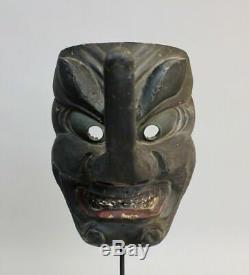

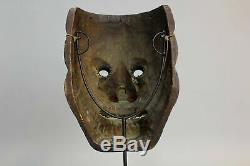
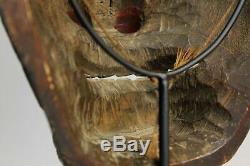
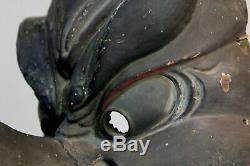
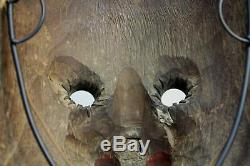
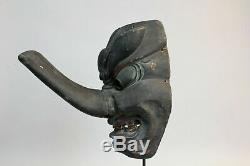
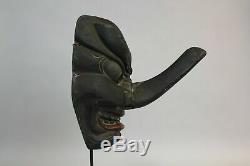


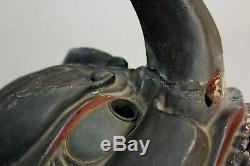

Quality early Mask depicting the Japanese Character: Tengu. Prior damage and repair at the base of the nose. Metal work around the eye. Deep, rich, layers of patina on the backside.
In the not-so-distant future folks will run affordable DNA tests via the patina and capture the detailed, ethnic. Origins and roots of those that once adorned these ethnographic, antique, masks like these.
One day, with more research, this piece will deserve to be a cultural-heritage item. Size: 22cm (8.65") x 17cm (6.7"). Included; the piece has had its string upgraded (not original to the item) to a coated-metal-wire for hanging purposes and ensure its longevity (wire not seen in these pics). The attention to details on this mask is exceptional: from the red-lacquer noted on the edge of the.
Nostrils, the artistic metal eyes that are secured to the back of the mask, and the fine-details of the teeth. The most exceptional art-form on this mask are undoubtedly the metal-overlays within the eyes. These were hand-crafted, yet fit the wooden confines of the mask in depth, circumference and shape to surgical precision! The raised, ring for the pupils on these overlays is attention-grabbing. Typically metal inserts around the eyes are typically reserved for masks depicting Japanese Gods (Kami), which is suggestive that this particular, early, rendition of Tengu was less the gullible and naive Tengu and more so the powerful, super-natural Tengu. Two holes per side further attesting to the prior use of this sacred item.Patina at the lower part of the chin are on par with those from. That were habitually rented from masks rental shops for multiple decades etc. Material: Wood with dark patina, natural pigments and antique lacquer. "Heavenly dog" are a type of legendary creature. Found in Japanese folk religion.
Although they take their name from a dog-like Chinese. , the tengu were originally thought to take the forms of birds of prey.And they are traditionally depicted with both human and avian characteristics. The earliest tengu were pictured with beaks, but this feature has often been humanized as an unnaturally long nose, which today is widely considered the tengu. S defining characteristic in the popular imagination.
Long held that the tengu were disruptive demons. Their image gradually softened, however, into one of protective, if still dangerous, spirits of the mountains and forests.
Tengu are associated with the ascetic. And they are usually depicted in the garb of its followers, the yamabushi. Tengu and a Buddhist monk, by Kawanabe Kysai. The tengu wears the cap and pom-pommed sash of a follower of Shugend.Debating with the tengu of Mount Hiko. The tengu's nose protrudes just enough to differentiate him from an ordinary yamabushi. The tengu in art appears in a variety of shapes. It usually falls somewhere between a large, monstrous bird and a wholly anthropomorphized. Being, often with a red face or an unusually large or long nose.
Early depictions of tengu show them as kite. Like beings who can take a human-like form, often retaining avian wings, head or beak. The tengu's long nose seems to have been conceived in the 14th century, likely as a humanization of the original bird's bill. This feature allies them with the Sarutahiko kami. Who is described in the 720 CE text the Nihon Shoki. With a similar nose measuring seven hand-spans in length. The two figures are often portrayed with identical red phallic-nosed mask designs. Some of the earliest representations of tengu appear in Japanese picture scrolls, such as the Tenguzshi Emaki. 1296, which parodies high-ranking priests by endowing them the hawk-like beaks of tengu demons.Tengu are often pictured as taking the shape of some sort of priest. Beginning in the 13th century, tengu came to be associated in particular with yamabushi. The mountain ascetics who practice Shugend. The association soon found its way into Japanese art, where tengu are most frequently depicted in the yamabushi's unique costume, which includes a distinctive headwear called the tokin.
Due to their priestly aesthetic, they are often shown wielding the khakkhara. A distinct staff used by Buddhist monks.Called a shakuj in Japanese. Tengu are commonly depicted holding a magical feather fan. In folk tales, these fans sometimes have the ability to grow or shrink a person's nose, but usually they are attributed the power to stir up great winds. Various other strange accessories may be associated with tengu , such as a type of tall, one-toothed geta.
Tengu as a kite-like monster, from Toriyama Sekien. The term tengu and the characters used to write it are borrowed from the name of a fierce demon from Chinese folklore called tingo. Chinese literature assigns this creature a variety of descriptions, but most often it is a fierce and anthropophagous. Canine monster that resembles a shooting star or comet.
It makes a noise like thunder and brings war wherever it falls. One account from the Shù Yì Jì. "A Collection of Bizarre Stories", written in 1791, describes a dog-like tingo with a sharp beak and an upright posture, but usually tingo bear little resemblance to their Japanese counterparts.
The 23rd chapter of the Nihon Shoki. Written in 720, is generally held to contain the first recorded mention of tengu in Japan. In this account a large shooting star appears and is identified by a Buddhist priest as a "heavenly dog", and much like the tingo of China, the star precedes a military uprising. For tengu are used in the text, accompanying phonetic furigana.
Characters give the reading as amatsukitsune (heavenly fox). De Visser speculated that the early Japanese tengu may represent a conglomeration of two Chinese spirits: the tingo and the fox spirits called huli jing. How the tengu was transformed from a dog-meteor into a bird-man is not clear.
Some Japanese scholars have supported the theory that the tengu's image derives from that of the Hindu. Who was pluralized in Buddhist scripture as one of the major races of non-human beings.Like the tengu , the garuda are often portrayed in a human-like form with wings and a bird's beak. The name tengu seems to be written in place of that of the garuda in a Japanese sutra. , but this was likely written in the Edo period. Long after the tengu's image was established. At least one early story in the Konjaku Monogatari.
Describes a tengu carrying off a dragon, which is reminiscent of the garuda's feud with the nga. In other respects, however, the tengu's original behavior differs markedly from that of the garuda , which is generally friendly towards Buddhism. De Visser has speculated that the tengu may be descended from an ancient Shinto. With both the garuda and the tingo when Buddhism arrived in Japan. However, he found little evidence to support this idea.A later version of the Kujiki. An ancient Japanese historical text, writes the name of Amanozako. A monstrous female deity born from the god Susanoo. S spat-out ferocity, with characters meaning tengu deity. The book describes Amanozako as a raging creature capable of flight, with the body of a human, the head of a beast, a long nose, long ears, and long teeth that can chew through swords.
An 18th-century book called the Tengu Meigik. Suggests that this goddess may be the true predecessor of the tengu , but the date and authenticity of the Kujiki , and of that edition in particular, remain disputed. Evil spirits and angry ghosts. Iga no Tsubone confronts the tormented spirit of Sasaki no Kiyotaka, by Yoshitoshi. Sasaki's ghost appears with the wings and claws of a tengu.
A collection of stories published in the late Heian period. Contains some of the earliest tales of tengu , already characterized as they would be for centuries to come. These tengu are the troublesome opponents of Buddhism, who mislead the pious with false images of the Buddha, carry off monks and drop them in remote places, possess women in an attempt to seduce holy men, rob temples, and endow those who worship them with unholy power. They often disguise themselves as priests or nuns, but their true form seems to be that of a kite. Throughout the 12th and 13th centuries, accounts continued of tengu attempting to cause trouble in the world. They were now established as the ghosts of angry, vain, or heretical priests who had fallen on the " tengu -realm". They began to possess people, especially women and girls, and speak through their mouths kitsunetsuki. Still the enemies of Buddhism, the demons also turned their attention to the royal family. Tells of an Empress who was possessed, and the kagami. Reports that Emperor Sanj was made blind by a tengu , the ghost of a priest who resented the throne. One notorious tengu from the 12th century was himself the ghost of an emperor. Tells the story of Emperor Sutoku. Who was forced by his father to abandon the throne.When he later raised the Hgen Rebellion. To take back the country from Emperor Go-Shirakawa. He was defeated and exiled to Sanuki Province. According to legend he died in torment, having sworn to haunt the nation of Japan as a great demon, and thus became a fearsome tengu with long nails and eyes like a kite's. In stories from the 13th century, tengu began to abduct young boys as well as the priests they had always targeted.
All of the tengu's victims, however, would come back in a state of near death or madness, sometimes after having been tricked into eating animal dung. The tengu of this period were often conceived of as the ghosts of the arrogant, and as a result the creatures have become strongly associated with vanity and pride.Today the Japanese expression tengu ni naru ("becoming a tengu ") is still used to describe a conceited person. Written in the late Kamakura period.
A god appears to Go-Shirakawa and gives a detailed account of tengu ghosts. He says that they fall onto the tengu road because, as Buddhists, they cannot go to Hell. Yet as people with bad principles, they also cannot go to Heaven. He describes the appearance of different types of tengu : the ghosts of priests, nuns, ordinary men, and ordinary women, all of whom in life possessed excessive pride. The god introduces the notion that not all tengu are equal; knowledgeable men become daitengu.
Greater tengu , but ignorant ones become kotengu. Lists the greatest of these daitengu as Sjb.The demons of Kurama and Atago are among the most famous tengu. Crow Tengu , late Edo period (28×25×58 cm).
Akiba Sanjakub Daigongen near the portal of the Hase-Temple Hasedera. A section of the Tengu Meigik , later quoted by Inoue Enry. Lists the daitengu in this order.
Of Mount Ueno Ueno Park. Daitengu are often pictured in a more human-like form than their underlings, and due to their long noses, they may also called hanatakatengu. Kotengu may conversely be depicted as more bird-like. They are sometimes called Karasu-Tengu.
Crow tengu , or koppa- or konoha-tengu. Described two kinds of tengu in his Tenguron : the great daitengu , and the small, bird-like konoha-tengu who live in Cryptomeria. The konoha-tengu are noted in a book from 1746 called the Shokoku Rijin Dan. , as bird-like creatures with wings two meters across which were seen catching fish in the i River. But this name rarely appears in literature otherwise.
Creatures that do not fit the classic bird or yamabushi image are sometimes called tengu. For example, tengu in the guise of wood-spirits may be called guhin (occasionally written kuhin). Dog guests , but this word can also refer to tengu with canine mouths or other features. The people of Kchi Prefecture. Believe in a creature called shibaten or shibatengu.
Lawn tengu , but this is a small childlike being who loves sum. Wrestling and sometimes dwells in the water, and is generally considered one of the many kinds of kappa. Another water-dwelling tengu is the kawatengu. River tengu of the Greater Tokyo Area.
This creature is rarely seen, but it is believed to create strange fireballs and be a nuisance to fishermen. (portable shrine) in the city of Beppu.
A book of Buddhist parables from the Kamakura period. Makes a point of distinguishing between good and bad tengu. The book explains that the former are in command of the latter and are the protectors, not opponents, of Buddhism although the flaw of pride or ambition has caused them to fall onto the demon road, they remain the same basically good, dharma. Abiding persons they were in life. The tengu's unpleasant image continued to erode in the 17th century. Some stories now presented them as much less malicious, protecting and blessing Buddhist institutions rather than menacing them or setting them on fire. According to a legend in the 18th-century Kaidan Toshiotoko. , a tengu took the form of a yamabushi and faithfully served the abbot of a Zen. Monastery until the man guessed his attendant's true form. The tengu's wings and huge nose then reappeared.The tengu requested a piece of wisdom from his master and left, but he continued, unseen, to provide the monastery with miraculous aid. In the 18th and 19th centuries, tengu came to be feared as the vigilant protectors of certain forests. In the 1764 collection of strange stories Sanshu Kidan. , a tale tells of a man who wanders into a deep valley while gathering leaves, only to be faced with a sudden and ferocious hailstorm. A group of peasants later tell him that he was in the valley where the guhin live, and anyone who takes a single leaf from that place will surely die.
In the Szan Chomon Kish. Who used a sort of rice cake called kuhin- mochi. To placate the tengu , who would otherwise perpetrate all sorts of mischief. The people of Ishikawa Prefecture. Have until recently believed that the tengu loathe mackerel.
And have used this fish as a charm against kidnappings and hauntings by the mischievous spirits. Tengu are worshipped as beneficial kami. (gods or revered spirits) in various Japanese religious cults. For example, the tengu Sabur of Izuna. Is worshipped on that mountain and various others as Izuna Gongen.
"Incarnation of Izuna", one of the primary deities in the Izuna Shugen cult, which also has ties to fox. Izuna Gongen is depicted as a beaked, winged figure with snakes wrapped around his limbs, surrounded by a halo of flame, riding on the back of a fox and brandishing a sword. Worshippers of tengu on other sacred mountains have adopted similar images for their deities, such as Sanjakub. Of Saij-ji Temple in Odawara. Upsets a nest of small tengu.
Tengu appear frequently in the orally transmitted tales collected by Japanese folklorists. As these stories are often humorous, they tend to portray tengu as ridiculous creatures who are easily tricked or confused by humans. Some common folk tales in which tengu appear include. "The Tengu's Magic Cloak". Tengu no Kakuremino : A boy looks through an ordinary piece of bamboo and pretends he can see distant places. A tengu , overwhelmed by curiosity, offers to trade it for a magic straw cloak that renders the wearer invisible. Having duped the tengu , the boy continues his mischief while wearing the cloak.Another version of this story tells of an ugly old man who tricks a tengu into giving him his magical cloak and causes mayhem for his fellow villagers. "The Old Man's Lump Removed". Kobu-tori Jiisan : An old man has a lump or tumor on his face.
In the mountains he encounters a band of tengu making merry and joins their dancing. He pleases them so much that they want him to join them the next night, and offer a gift for him. In addition, they take the lump off his face, thinking that he will want it back and therefore have to join them the next night. An unpleasant neighbor, who also has a lump, hears of the old man's good fortune and attempts to repeat it, and steal the gift. The tengu , however, simply give him the first lump in addition to his own, because they are disgusted by his bad dancing, and because he tried to steal the gift.
Tengu no Hauchiwa A scoundrel obtains a tengu's magic fan, which can shrink or grow noses. Later he accidentally fans himself while he dozes, and his nose grows so long it reaches heaven, resulting in painful misfortune for him. "Tengu no Hytan" : A gambler meets a tengu , who asks him what he is most frightened of. The gambler lies, claiming that he is terrified of gold or mochi. The tengu answers truthfully that he is frightened of a kind of plant or some other mundane item.
The gambler is of course delighted and proceeds to scare the tengu away with the thing he fears most. The gambler then obtains the tengu's magic gourd (or another treasured item) that was left behind. "The Tengu, and the Woodcutter": A tengu bothers a woodcutter, showing off his supernatural abilities by guessing everything the man is thinking.The woodcutter swings his axe, and a splinter of wood hits the tengu on the nose. The tengu flees in terror, exclaiming that humans are dangerous creatures who can do things without thinking about them.
Crow-Tengu (karasu-tengu) supervising a competition with small bows. Printed in Ykyu hidensho (Secret Tradition of the Small Bow), 1687. Ushiwaka-maru training with the tengu of Mount Kurama, by Kunitsuna Utagawa. This subject is very common in ukiyo-e.
Japan's regent Hj Tokimune. Who showed down the Mongols, fights off tengu. An elephant and a flying tengu , by Utagawa Kuniyoshi. During the 14th century, the tengu began to trouble the world outside of the Buddhist clergy, and like their ominous ancestors the tingu , the tengu became creatures associated with war. Legends eventually ascribed to them great knowledge in the art of skilled combat. This reputation seems to have its origins in a legend surrounding the famous warrior Minamoto no Yoshitsune.When Yoshitsune was a young boy going by the name of Ushiwaka-maru, his father, Yoshitomo. Was assassinated by the Taira clan. Head of the Taira, allowed the child to survive on the grounds that he be exiled to the temple on Mount Kurama.
But one day in the Sj-ga-dani Valley, Ushiwaka encountered the mountain's tengu , Sjb. This spirit taught the boy the art of swordsmanship so that he might bring vengeance on the Taira. Originally the actions of this tengu were portrayed as another attempt by demons to throw the world into chaos and war, but as Yoshitsune's renown as a legendary warrior increased, his monstrous teacher came to be depicted in a much more sympathetic and honorable light. In one of the most famous renditions of the story, the Noh. Play Kurama Tengu , Ushiwaka is the only person from his temple who does not give up an outing in disgust at the sight of a strange yamabushi. Sjb thus befriends the boy and teaches him out of sympathy for his plight.Two stories from the 19th century continue this theme: In the Szan Chomon Kish , a boy is carried off by a tengu and spends three years with the creature. He comes home with a magic gun that never misses a shot. A story from Inaba Province. Tells of a girl with poor manual dexterity who is suddenly possessed by a tengu.
The spirit wishes to rekindle the declining art of swordsmanship in the world. Soon a young samurai appears to whom the tengu has appeared in a dream, and the possessed girl instructs him as an expert swordsman. Some rumors surrounding the ninja. Indicate that they were also instructed by the tengu. The tengu shinobi society in Tokyo, Japan has mentioned several times that they are the oldest ninja clan in existence and were around during the days of the Koga and Iga.Some grand masters have said that the ninja legends of the tengu came into existence shortly after the arrival of the ninja in Japan and that the very first ninjas were called tengu giving the legend its birth. A rumor from 1980's Japan stated that not only was the tengu shinobi society the clan that gave birth to the tengu legend, but they were also superior to the Koga and Iga, but were much more secretive. Profoundly entrenched in the Japanese imagination for centuries, tengu continue to be popular subjects in modern fiction, both in Japan and other countries. They often appear among the many characters and creatures featured in Japanese cinema.
Character U+1F47A represents a tengu , under the name "Japanese Goblin". The item "Exceptionally Rare Antique (ca 1600s-1700s), Japanese/Japan, Wooden Tengu Mask" is in sale since Thursday, August 29, 2019. This item is in the category "Antiques\Asian Antiques\Japan\Masks". The seller is "maskmonger" and is located in Freeport, Maine. This item can be shipped worldwide.
- Type: Masks
- Region of Origin: Japan
- Age: 1600-1700
- Primary Material: Wood
- Original/Reproduction: Antique Original
- Featured Refinements: Japanese Mask

